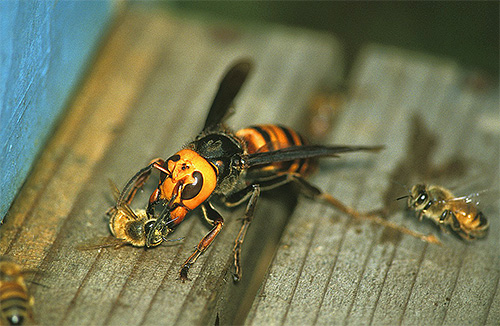
There is an opinion that hornets against bees wage a real war of extermination. A lot of videos, "walking" on the Internet, and even professionally filmed scientific and educational short films clearly show how one hornet against hundreds of bees manages not only to withstand, but also to destroy numerous rivals.
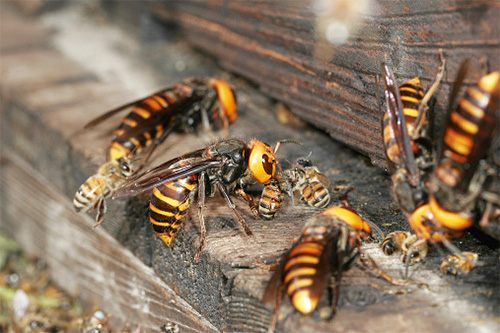
However, only to the viewer, far from entomology, it may seem that the hornets conduct a peculiar and specifically directed genocide against bees. In fact, everything is much more banal.
It's no secret that hornets are the killers of almost any insects. Although it is not entirely correct to put the label “killer” in its well-known sense on these big os, because they are just simple hunters who produce meat for feeding their larvae.
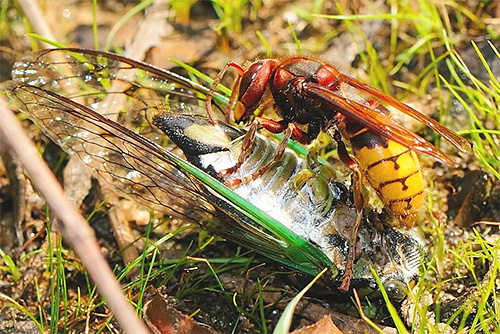

For continuous growth and normal functioning of the colony, working individuals are forced to continuously find new prey, kill it and bring it to the nest.These insects are simply programmed by nature for such behavior. And it doesn’t matter whether a caterpillar, a bee or even a little frog falls under the powerful jaws of a hornet, a dexterous hunter will do everything possible so that the prey will benefit his family.
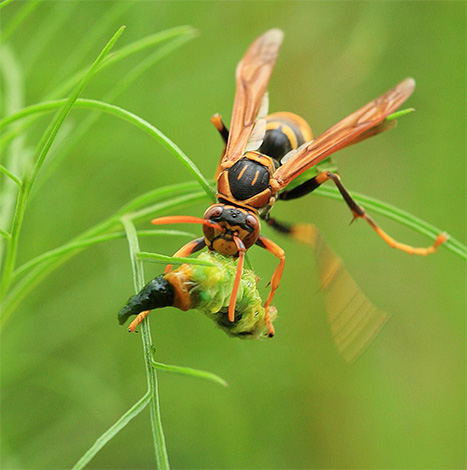
On a note
By and large, the hornet is a killer exactly to the same extent as this formidable word can be called, for example, an ant. Everyone knows that every ant constantly brings small caterpillars, larvae of beetles and other insects to its dwelling, but no one calls it a killer. Perhaps this is because the ant hunt is still not as spectacular and accessible to the observer, such as, for example, the struggle of the praying mantis and the hornet.
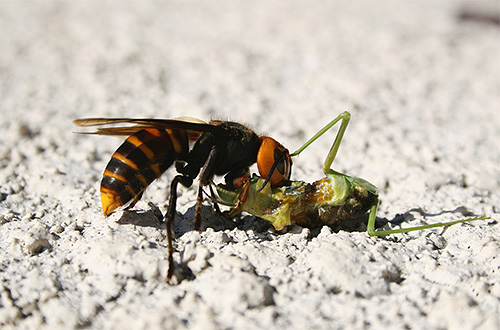
The bee hive for the hornet is almost an ideal forage object. First, near the nest, these honey insects gather in large numbers, so they are easy to catch. Secondly, they are the most valuable source of nutrients for predator larvae. And finally, thirdly, the ruin of the hive makes it possible to enjoy honey, and this is especially pleasant for large wasps, since their adults eat mostly sweet foods.

Thus, the presence of at least one hive in the habitat of winged predators really provides the entire colony with a complete, balanced diet, and without much difficulty. It is not surprising that hornets kill bees often and in large quantities, although they do not specialize only in hunting them.
Hornets and Bees: Hunters and Victims
A bumblebee, a hornet, a bee and a wasp are representatives of a large order of hymenoptera, which also includes ants and horsemen. They all share similarities in appearance and some features of behavior.
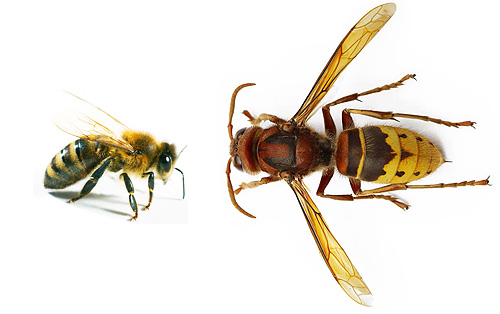
However, hornets, wasps, bees and bumblebees are, in addition, the owners of the poisonous sting.
It is interesting
Some quite primitive tropical ants are also equipped with a sting, and their bite is much more painful than the bite of a usual bee.
The toxins of all poisonous insects of this order are generally quite similar in their composition. However, the poison of each particular species has a number of features that determine its effect on the body that is stung.
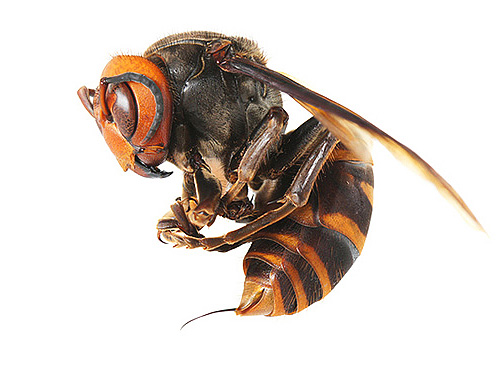
For example, hornet venom is highly allergenic, it is stronger than others affects the nervous receptors of the enemy.But at the same time, bee venom causes more severe poisoning of the body due to the large amount of toxin injected at a time.
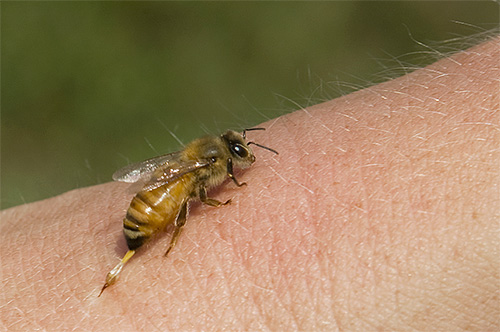
As already noted, different types of insects are poisonous in various ways. For example, an ordinary hornet stings, of course, hurts, but its bites are rarely accompanied by serious consequences. And here is a huge asian hornet is one of the most dangerous insects on Earth.

In the video you can see in detail how the hornet kills bees - it uses its powerful jaws for this, and not poison, as it may seem to an uninformed viewer.
In the hunt of hornets, a certain pattern can be seen on bees - in most cases, predators do not attack single prey that collect nectar. They act more cunningly - track them down and fix the location of the nest, in order to return here already in greater numbers.
Depending on the type of winged predators, a different number of attackers is required to completely destroy the hive of the honey-bearing prey. This rule is almost always valid, however, there are some nuances here.
So, for example, if we are talking about European hornet, then theoretically only a few hundred predatory insects can destroy a hive of 10-15 thousand individuals.However, very rare families of hornets reach such a size by the end of the summer, and therefore in our country these predators prefer to attack single bees without risking attacking hives. But even in such cases, the damage to the apiaries is quite noticeable.

It is quite another thing - giant Asian hornets, killers, measuring almost twice as large as those of European relatives. Having no special methods to protect the bees against the hornets of this species is absolutely helpless. Let's dwell on these formidable, but not less interesting, predators.
Giant hornets and their bee hunting
One of the determining factors of the superiority of the giant Asian hornet over smaller relatives is its size. The body length of this largest wasp is more than 5 cm, i.e. almost three times more than the same parameters of a working bee. With one verified movement of the jaws, the huge attacking predator easily breaks the articulation of the head and chest of his victim, after which she is paralyzed and can no longer move.
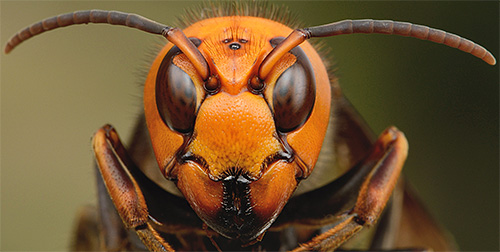
In a minute, such a hornet can kill more than 30 bees, and a squad of only 30–40 predators needs only a few hours to destroy a large honey-bearing family.
It is interesting
The chitinous cover of the body of the hornet is so hard that bees, defending themselves, can pierce it with a sting only in some places. But in this case, the attacking insect will not suffer much.

The video usually shows clearly how huge hornets act against bees defending their hive: predators practically do not use the sting.
The attack of several hornets on the beehive
And since the bee colony is such a "tidbit" for the hornet, the latter eagerly seek hives and destroy entire families.
Interestingly, the war of the bees against the hornets is a process started by man. Without its influence, there is no such active extermination in nature.
Bees as a defender: their capabilities and secret weapon
In nature, the giant Asian Hornet and European Honeybee species do not intersect with each other: the first lives in Japan and Southeast Asia, the second in Europe and the Middle East.
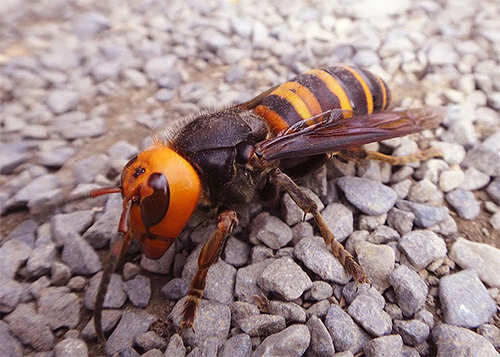
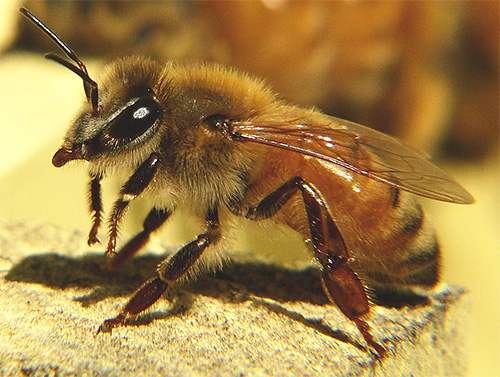
But Asian bees are struggling with hornets in a very original, developed during the joint evolution, method: a large number of potential victims cling to the predator, forming around him a huge ball, up to 30 cm in diameter, from its bodies.At the same time insects actively move their wings.
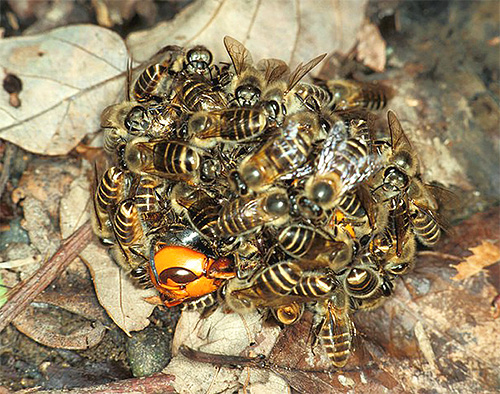
This behavior is explained by the fact that from such muscular work the air inside the ball heats up, and the heat from the movement of the wings is directed to its center, i.e. to the attacking insect. For a giant predator, the temperature at 46-47 ° C is fatal; therefore, after an hour of being in such a ball, it dies, destroying only a few nest owners. The bees themselves are able to tolerate temperatures normally up to 50 ° C, and those that did not fall under the jaws of the dying giant wasp survive.
It is interesting
For the organization of one ball and the destruction of one hornet need about 500 bees. A family of 15–20 thousand working individuals is able to withstand the attack of 30–35 hornets, which reliably protects them from these natural enemies.
If we talk about European bees living in the latitudes of our country, it is worth noting that they do not know how to defend themselves in this way. In the wild, local hornets practically do not attack honeybee hives, and therefore evolutionary similar defensive behavior in European bees has not been developed.
But these insects collect much more honey, which is why Japanese beekeepers bring in and actively try to breed them in their habitats. giant hornets.
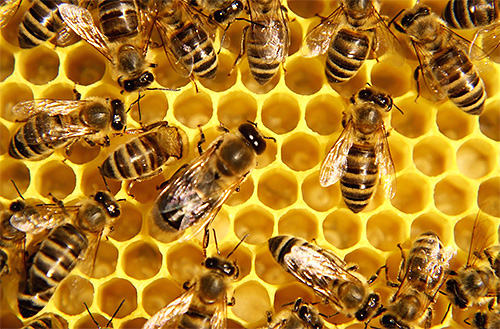
As mentioned above, the war of bees against hornets is an artificial phenomenon, provoked entirely by man. Therefore, the attempts of Asian beekeepers rarely end in success - when huge predators find a hive that cannot defend themselves, the real slaughter begins. Without the forced migration of bees to the other side of the mainland, this would not have happened.

By the way, this is why most of the videos with the attack of hornets on bees are removed in artificial evidence. European bees are not able to breed in the natural conditions of Asia, because predatory giant wasps can attack them only in an apiary.
Hornets vs. Bumblebees: Who is Stronger When Meeting?
The relations of giant wasps with other insects are similar to their relationships with bees: almost any arthropod that is inferior to this predator in size and strength is its potential victim. Let's define the brightest opponents of the Hornets.
The hornet and the bumblebee are the obvious hunter and prey.
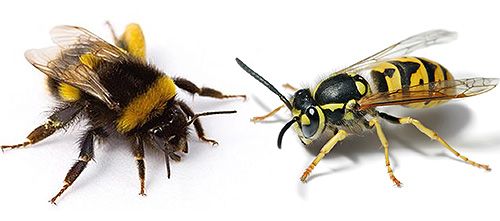
A bumblebee is also defenseless in front of this predatory insect, like a bee, only more effort is needed to kill it.However, it is worth noting that the European hornet will hardly attack the bumblebee due to its small size, but the Asian hornet is quite capable of it.
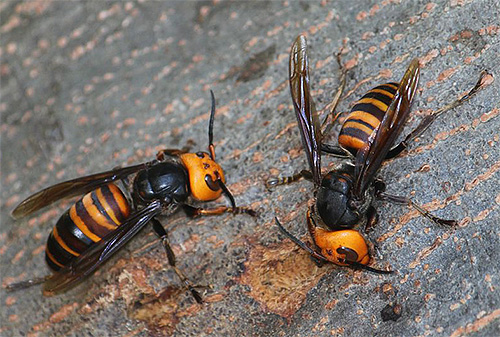
Thus, if the sizes of rivals are approximately equal, it is impossible to say for sure who is stronger - a bumblebee or a hornet. Chances are that when meeting the bumblebee against the hornet will stand.
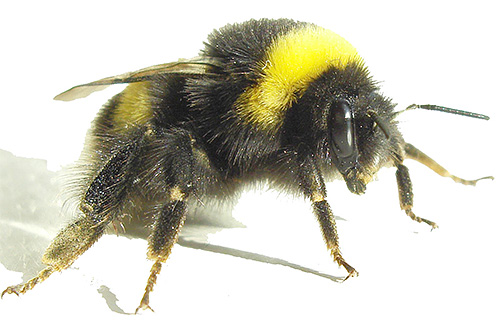
It is also rash enough to say that these insects are enemies. In most cases, they are still neighbors who simply have to endure each other. The bumblebee differs from the hornet in greater peace-lovingness, and also in that it is not a predator. Nevertheless, he is able to give a fitting rebuff to the attacker.
Collisions of these insects in wildlife are almost never recorded, and therefore the video “the hornet against the bumblebee” is a rarity. Here is one of the few examples:
Hornet cracks down on the bumblebee
- The hornet and the wasp are generally a similar pair of “predator-prey”.

- The attacks of the hornet's nest wasps are extremely rare, since the wasps are exactly the same predators, and, having gathered a large number, they are able to successfully resist the attackers.
- The mantis against the hornet, unlike the two previous rivals,practically helpless.
- Powerful legs - the only weapon of the praying mantis against the aggressors - are not capable of harming the major wasp. The hornet against such a victim does not even use poison, because to win it is enough for him to gnaw a joint in the neck area from an insect.
The video shows how the hornet kills the mantis:
Giant asian hornet against mantis
To whom the hornet will give way in battle
By analogy with previous connections of hornets, it is possible to identify those who would rather be an aggressor in relation to this insect.
The relationship between winged predators and spiders stand apart from all others.

Interestingly, the spider against the hornet can look like a victim, and as a killer at the same time. For example, medium-sized spiders, hunting without creating a web - small tarantulas, horses, haymakers - often fall into the jaws of the hornet and die. But if the insect itself caters to the web, even if it is not a very large and small cross-spider, then it will most likely be eaten.
The video shows how quickly and masterfully the spider cracks down on the hornet in its web:
Spider against hornet
The hornet against the tarantula spider has an average chance of winning.These rivals have about the same body size, but the spider's body, among other things, is supplied with the strongest poison and very powerful chelicerae. Therefore, in this skirmish, the one who first bites wins.
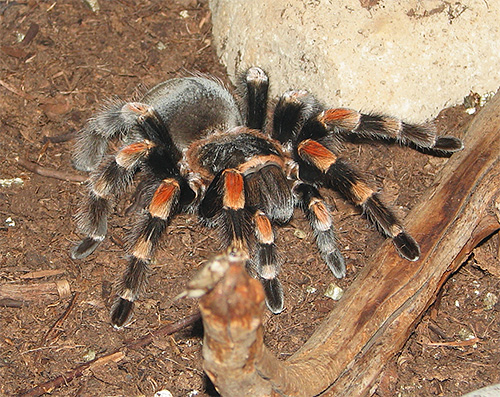
The closest relatives of hornets - large road wasps and stray ants - can also be formidable rivals.
Despite their physiological adaptability to the killing, the hornets themselves often become their victims. This is explained by the fact that the wasps have a very powerful poison, fatal to the hornet, and the ants just take the amount - they always attack the group.
One of the most original biological enemies of hornets is a unique mushroom that grows in the brain of an insect.
The spores of this fungus enter the body of the hornet through the mouth or respiratory tract and germinate in its head. The mycelium during its development produces special substances that cause a feeling of constant thirst in an insect.
Willy-nilly, driven by instinct, the hornet is looking for a place suitable for drinking, and here the developing killer fungus causes paralysis of the insect. The victim stops in a completely unexpected position - for example, hanging on a blade of grass.
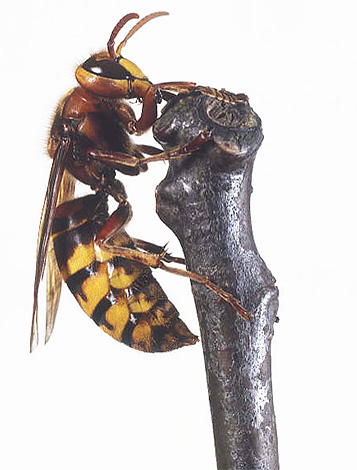
At the last stage of its life cycle, the parasite releases the fruit body, thereby spreading new spores already in a moist environment favorable for this process. Thus, a predatory insect by its death gives life to another, albeit so ambiguous, living organism. Entomologists often find wasps and hornets with dried fungus bodies protruding from the head.
Hornets also have enemies among vertebrates.
Bee-eaters, birds that specialize in feeding on bees and wasps, catch the hornet so that it cannot sting them. After they break an insect on a stone and, without causing harm to their health, they swallow it.
Similarly, some other insectivorous birds can feed on hornets. But of the mammals, the man is uniquely dangerous for this insect only, who learned without much difficulty to destroy not only individual wasps, but also their nests.

However, most often hornets perish not from the “hand” of worthy opponents, but from small parasites - ticks, nematodes and horsemen, which they cannot destroy.
Summing up, it is impossible not to mention the well-known scientific fact: there is nothing useless in living nature.The life cycle of each organism is subject to strict laws; Each organism in nature occupies its own niche and can serve to some extent as a predator or prey.
So is the hornet: there are objects that it eats, acting as a formidable killer, and there are those that destroy it, without paying any attention to the full power of the biological weapons of this insect.
Interesting video: bees together kill the hornet
Hornet against scorpion



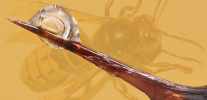
Thanks for the article, it was very interesting to read and see!
Interesting ... Thank you.
I did not find the answer to my question: why does a cat eat dry hornets? Right crunches them. Maybe there is chitosan in dry hornets, but why does a cat need it?